The goal of this project was to connect with the local community through growing food and learning about and taking action for community food security and resilience.
The context of Sustainable Communities through Kai looks at strengthening connections with the land that nurtures us, and the people that collectively contribute to food supply and security. By connecting communities through kai, our living landscapes can meet our physical and social needs, and enhance our resilience, self-reliance and health.” – p 6 Enviroschools Sustainable Communities through Kai booklet

Together, creating a healthy garden ecosystem.
Guerilla gardening (gardening on land that the gardeners do not have the legal rights to cultivate) during the Covid pandemic led to a new community maara kai, in a greenspace that was originally designated as a roadway. During the lockdowns, residents started to grow kai in Gudex Court, a Hamilton City (HCC) council-owned reserve bordered by Kāinga Ora owned homes. The HCC transport team was inspired and proposed a more permanent community garden. Community Advisor, Ioana Manu, approached Enviroschools Waikato to engage with the local school and support the creation of a new community maara kai for nearby residents.
Discussions were started by Kāinga Ora staff and the Community Engagement team at HCC on how to better support the community and utilise the space. Both cars and dogs had access to the space making it less safe and friendly.
A vision to create a welcoming, community-friendly space emerged, where tamariki could play, and fruit and vegetables could be grown and produce shared. Kainga Ora fenced properties (keeping dogs safe in their gardens) and HCC put in bollards to stop vehicle access but then wanted to know how they could get support to get the maara back up and running. In 2023 Te Au o Tamatea and Enviroschools were called on to support the idea.
After initial meetings with the HCC team, Enviroschools Facilitator, Alex Daniel, met with students and teacher, Keri Sinclair from Te Ao o Tamatea Saint Andrews Middle School to plan and develop the garden. Students discussed what they liked to eat, what would grow well and how much space would be needed for the beds and pathways. They also planned for fruit trees that would need minimal maintenance.
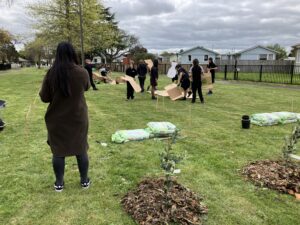
Students laying out the cardboard in the marked-out spaces as a barrier beneath the no-dig garden bed.
Local residents, school students, kaumātua, HCC and Kāinga Ora staff gathered in October 2023 for an official blessing and opening ceremony, and to begin the fruit tree planting. Students had compiled their ideas into a garden plan. They mapped and marked out the garden space, laid wet cardboard and layered pea straw, mulch and compost to prepare the no-dig garden beds. HCC funding supported the purchase of a range of fruit and vegetable plants.
In the first Spring, students planted tomatoes, chillies, capsicum, beans, spinach, lettuce, silver beet, potatoes, pumpkin, corn and kūmara. They used a wide range of herbs and flowers including lavender, basil, calendula, sage, sunflowers and marigolds to provide bursts of colour, be a draw for bees and encourage pollination. Alex, Keri and students met every Friday afternoon during term (with a few exceptions due to weather or planned events) to plant seedlings, water, weed and mulch the gardens. At the end of 2023 the first vegetables were ready to be harvested and shared with the community.
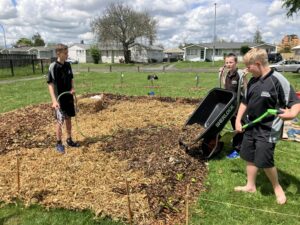
Building up the no-dig garden bed.
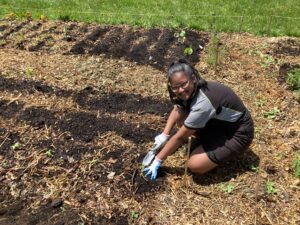
Planting the vegetable seedlings. So much potential!
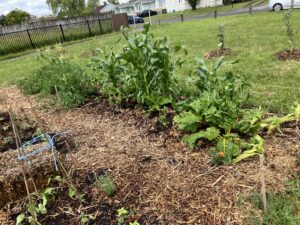
A succession of planting to ensure supply.
Watering was an issue, as there was no plumbed in supply on site and there were concerns for maintaining the crops over the hot school summer term break. This was solved by community members who were happy to supply water for the students to use on the garden and act as kaitiaki for the garden during school holidays. The garden beds had also been deeply mulched to retain moisture and feed the whenua. HCC supplied huge volumes of mulch (from trees felled during storms) and “tronpost”, the compost made from the city kerbside food waste collections.
“Land is more than the ground we stand on. Land provides for our needs, as the word whenua implies, making association between land, nourishment and security. For our children, landscapes can be a magical world with secret places to hid, play and imaging, providing a wealth of learning experiences.” – p 7 Enviroschools Living Landscape Theme Area.
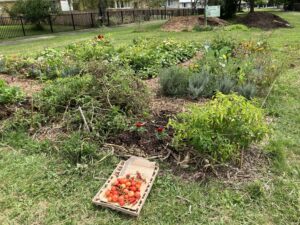
Late summer bounty.
The maara kai went from strength to strength in its first season, thanks to regular mahi from staff, students and community. By autumn 2024 chilli, silver beet and basil were still producing well, but the tomatoes were coming to an end. After a full moon it was time to harvest the first kūmara crop. Alex supported students and staff to harvest, weigh, brush, sort and store 11.5kgs of kūmara Taputini (an ancient variety with cream skin and flesh), 15kgs of Ōwairaka Red – a total harvest of 27kgs, with the largest single kūmara a red at a whopping 1.7kg! The crop was shared with the local community at a picnic event on a cool wintery afternoon, along with lots of feijoas and chillis from the maara.
“The garden provides an opportunity for people to connect with their community and to the whenua and empower the community to grow their own food. Growing your own food in your backyard can also help people to save money on groceries and improve wellbeing. The garden will improve the safety of the reserve for tamariki, as vehicles won’t be able to access the grassed areas, which had previously been an issue. The collaborative project will help to build a sense of community ownership and pride of the previously unused space. In tough economic times, it can also help to reduce food costs for families.” – Ioana Manu, Community Advisor, Hamilton City Council
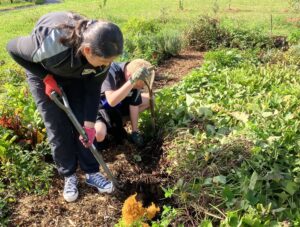
Time to see what is beneath the growth and soil.

Impressive harvest!
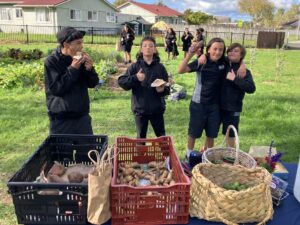
A significant milestone of celebrating the first harvest.
Following the kūmara harvest, community members composted and mulched the beds to prepare for winter planting of silver beet, winter greens, brassicas and rhubarb. As growing slowed over the cooler months the school students used the time to build a kitset 2-bay macrocarpa compost bin, and to start designing a pātaka kai where food can be shared.
New signage has been implemented to encourage greater community connection with the space and future plans include building a seating areas, garden art and the installation of a tap and water supply (with support from council).
Kāinga Ora Community Engagement and Partnerships Manager, Andy Mannering said, “the changes being initiated at Gudex Court are a great example of multiple people working together to enhance the lives of those living there”.
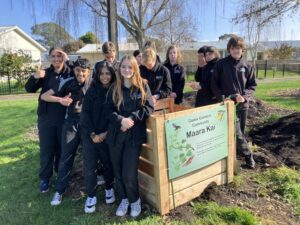
The sign that shares the vision and encourages connection and contribution.
The outcomes have been numerous already. The practical aspects such as learning about and growing healthy kai then sharing this within the community is evident and will continue. The faces of all those involved indicate the empowerment of learners involved. This project has shown the power of working in partnership towards a shared vision, for the benefit of the community.
The garden continues to provide a space for learning, a place to build connections and a way of providing kai. Students from Te Ao o Tamatea Saint Andrews Middle School will continue to regularly care for this place with the aim of increasing community engagement with the gardens over time. This spring it is planned to increase the garden size adding even more room for growing kūmara after such a successful first harvest!